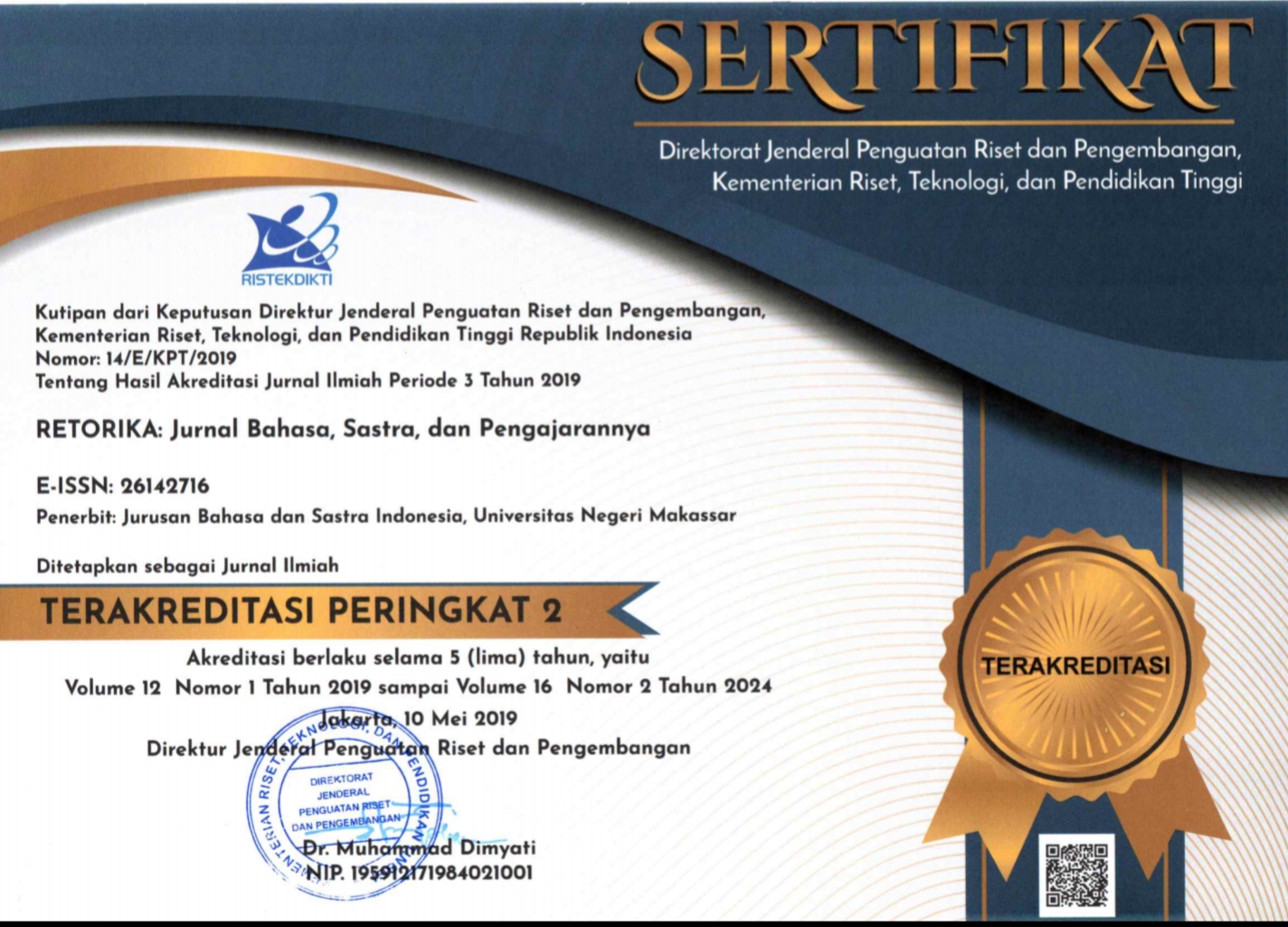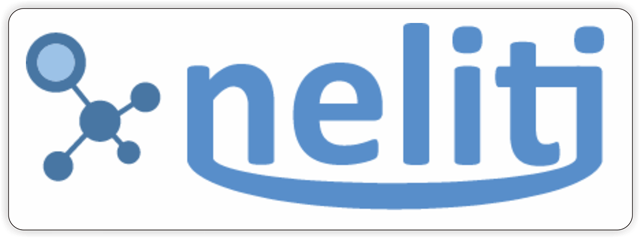ISLAMIC DIDACTIC LITERATURE IN THE NOVEL “CINTA DI UJUNG SAJADAH” BY ASMA NADIA
(1) Universitas Pendidikan Indonesia
(2) Universitas Pendidikan Indonesia
(3) Universitas Pendidikan Indonesia
(4) Universitas Pendidikan Indonesia
(*) Corresponding Author
DOI: https://doi.org/10.26858/retorika.v13i2.13795
Abstract
This research aimed to describe didactic literature in the Islamic novel Cinta Di Ujung Sajadah (CDUS, 2012) by Asma Nadia in terms of the contents/expressions of Islamic literary didacticism. This type of research was qualitative research using descriptive methods. Data analysis was carried out based on the didacticism expression theory. The results showed that the Islamic novel CDUS (2012) by Asma Nadia (1) has contents/expressions that are in accordance with the aqeedah, sharia, ihsan (morals). (2) is a didactic literature that provides moral, religious, and social teaching. (3) charged dimensions of factual, conceptual, procedural, and metacognitive knowledge. (4) can be used as sources and solutions based on sharia science. Islamic didactic literature found in the novel CDUS (2012) by Asma Nadia is very relevant to be used as a source of literacy to improve the morale of students.
Keywords
Full Text:
PDFReferences
Abrams, M.H. 1999. A Glossary of Literary Terms. New York: Holt, Rinehart & Winston.
Alfianika, N., Sunendar, D., Sastromiharjo, A., & Damaianti, V. S. 2019. Needs Analysis: Students’ University Learning in Writing Scientific Papers. Journal for the Education of Gifted Young Scientists, 7(4), 15, 915–929.
Anderson, L.W., & Krathwohl, D.R. 2010. Kerangka Landasan untuk Pembelajaran, Pengajaran, dan Asesmen [Foundation Frameworks for Learning, Teaching, and Assessment]. Translated by Agung Prihantoro. Yogyakarta: Pustaka Pelajar.
Ausop, A. Z. (2014). Islamic Character Buiding. Bandung: Salamadani.
Brown, W. P. 2004. The didactic power of metaphor in the aphoristic sayings of proverbs. Journal for the Study of the Old Testament, 29(2), 133–154.
Cahyo, E. D. 2017. Pendidikan karakter guna menanggulangi dekadensi moral yang terjadi pada siswa sekolah dasar [Character education to overcome moral decadence that occurs in elementary school students]. EduHumaniora | Jurnal Pendidikan Dasar Kampus Cibiru, 9(1), 16.
Creswell, J. W. 2012. Educational Research: Planning, Conducting, and Evaluating Quantitative and Qualitative Research (4th ed). Boston: Pearson.
Damaianti, V. S., Damaianti, L. F., & Mulyati, Y. 2017. Cultural Literacy Based Critical Reading Teaching Material with Active Readerstrategy for Junior High School. International Journal of Evaluation and Research in Education (IJERE), 6(4), 312.
Fatah, A. 1993. Pemikiran tentang Fungsi Didaktis dalam Kesusastraan [Thoughts on Didactic Functions in Literature]. Jakarta: Fakultas Sastra Universitas Indonesia.
Ghazali, A.I. 2014. Ihya’ ’Ulumuddin (buku pertama): Biografi Al-Ghazali, Ilmu,Iman (Revisi). Bandung: Marja.
Herfanda, A. Y. 2012. Membentuk karakter siswa dengan pengajaran sastra [Shaping student character by teaching literature]. Universitas Swadaya Gunung Jati: Tuturan., 1, No 1, 13.
Huda, M. H., Ghazali, A. S., Iswanto, W., & Hasanah, M. 2019. Cognitive Level of Characters in the Indonesian Novel As a Source of Learning. Journal for the Education of Gifted Young Scientists, 931–952.
Iskarim, M. 2017. Dekadensi moral di kalangan pelajar (Revitalisasi Strategi PAI dalam Menumbuhkan Moralitas Generasi Bangsa) [Moral decadence among students (Revitalization of PAI's Strategy in Fostering Morality of the Nation's Generation)]. Fakultas Tarbiyah dan Ilmu Keguruan IAIN Pekalongan., 1.
Jones, W. R. 1976. The didactic poet as educator in the eighteenth century. Studies in Adult Education, 8(2), 175–182.
Kementerian Agama Republik Indonesia. Al-Qur’an dan Terjemahannya [Al-Quran and its Translation]. Diambil 18 Januari 2020, dari https://quran.kemenag.go.id/
Lestari, U.F.R. 2012. Unsur didaktis dalam syair lagu rakyat Papua [Didactic elements in Papuan folk song lyrics]. ATAVISME, Vol. 15, No. 2, Edisi Desember 2012: 247-259.
Mohamad, G. 1982. Sejumlah Masalah Sastra [A Number of Literary Problems]. Jakarta: Sinar Harapan.
Nadia, A. 2012. Cinta Di Ujung Sajadah. Jakarta: Republika.
Nadirah, S. 2017. Peranan pendidikan dalam menghindari pergaulan bebas anak usia remaja [The role of education in avoiding promiscuity among teenagers]. Palu: Musawa, 9, 309–351.
Najib, M.R.A., Panggalih, S., Turahmat. 2017. Segitiga didaktis cerpen merawat peti ingatan karya Putu Oka Sukanta [The short story didactic triangle treats the memory chest by Putu Oka Sukanta]. Jurnal Pendidikan Bahasa Indonesia Volume 5 Nomor 1 (Januari-Juni) Tahun 2017.
Ningrum, D. 2015. Kemerosotan moral di kalangan remaja: Sebuah penelitian mengenai parenting styles dan pengajaran adab [Moral decline among adolescents: A study of parenting styles and ethical teaching]. Unisia, 37(82), 18–30.
Nofasari, E., Sumiyadi, & Alfianika, N. 2018. Pengkajian sastra didaktis novel bidadari bermata bening karya Habiburrahman El Shirazy [The didactic literature study of Bidadari Bermata Bening novel by Habiburrahman El Shirazy]. Bandung: Prodi Pendidikan Bahasa Indonesia SPs. UPI.
Nordquist, R. 2019. Didacticism: Definition and examples in literature. ThoughtCo.
Pantu, A., & Luneto, B. 2014. Pendidikan karakter dan bahasa [Character and language education]. Institut Agama Islam Negeri Sultan Amai Gorontalo, 14, 153–170.
Peraturan Pemerintah Republik Indonesia Nomor 75. 2014. Peraturan Pemerintah Republik Indonesia Nomor 57 Tahun 2014 tentang Pengembangan, Pembinaan, dan Pelindungan Bahasa dan Sastra, serta Peningkatan Fungsi Bahasa Indonesia [Government Regulation of the Republic of Indonesia Number 57 of 2014 concerning Development, Development and Protection of Language and Literature, as well as Enhancing the Function of the Indonesian Language]. Lembaran Negara RI No. 157, 2014.
Sari, A.P.I., & Mayrita, H. 2016. Nilai-nilai didaktis cerita rakyat Sumatera Selatan [The didactic values of the folklore of South Sumatra]. Jurnal Bina Bahasa Vol.5 No. 14, Desember 2016, 1-22.
Seyyed, H. N. 1997. Islamic art and spirituality. State University of New York Press.
Sriraman, B., & Adrian, H. 2004. The use of fiction as a didactic tool to examine existential problems. Journal of Secondary Gifted Education, 15(3), 96–106.
Suharni. 2016. Mencegah kemerosotan moral dan perilaku menyimpang melalui konseling berbasis kearifan lokal [Prevent moral decline and deviant behavior through counseling based on local wisdom]. Proceedings International Seminar FoE (Faculty of Education, 1, 241–147.
Sumiyadi. 2016. Memperkukuh jati diri bangsa melalui sastra didaktis [Strengthening national identity through didactic literature]. Seminar Nasional Pengembangan Literasi Berbasis Kearifan Lokal Pengukuhan Jati Diri Kebudayaan Bangsa, 72–82.
Sundana, L., Sastromiharjo, A., & Sumiyadi. 2018. Sastra didaktis dalam pembelajaran apresiasi sastra [Didactic literature in literary appreciation learning]. riksabahasa@upi.edu, 1085–1094.
Sunendar, D. 2015. Strategi Optimalisasi Pembelajaran Bahasa Indonesia pada Era Mea [Strategies for Optimizing Indonesian Language Learning in the Mea Era]. Seminar Nasional Pendidikan Bahasa Indonesia 2015, 5.
Suryaman, M. 2010. Pendidikan karakter melalui pembelajaran sastra [Character education through literary learning]. FBS Universitas Negeri Yogyakarta, 15.
Suwondo, T. 2017. Sastra Dan Pendidikan [Literature and Education].
Suyatmi, T. 2012. Fungsi didaktis sastra dalam pembinaan akhlak manusia [Literary didactic function in building human morals]. Jurnal Tuturan, Vol.1, No.2, 165–172.
Teeuw, A. 1988. Sastra dan Ilmu Sastra [Literature and Humanities]. Bandung: Pustaka Jaya.
Wellek, R., & Austin, W. 1989. Teori Kesusastraan [Literary Theory]. Translated by Melani Budianta. Jakarta: PT. Gramedia.
Article Metrics
Abstract view : 522 times | PDF view : 72 timesRefbacks
- There are currently no refbacks.
Copyright (c) 2020 Erlinda - Nofasari, Dadang - Sunendar, Sumiyadi - Sumiyadi, Vismaia Sobariah Damaianti

This work is licensed under a Creative Commons Attribution-NonCommercial 4.0 International License.
Published by:
Department of Indonesian Language, Faculty of Languages and Literature, Universitas Negeri Makassar in cooperate with Asosiasi Dosen Bahasa dan Sastra Indonesia (ADOBSI) and Ikatan Program Studi Pendidikan Bahasa dan Sastra Indonesia (IKAPROBSI).
Address: Department of Indonesian Language Office, DG Building Second Floor, UNM Parangtambung, Daeng Tata Raya Street, Makassar, South Sulawesi, Indonesia
 Email: retorika@unm.ac.id
Email: retorika@unm.ac.id

RETORIKA: Jurnal Bahasa, Sastra,dan Pengajarannya is licensed under a Creative Commons Attribution-NonCommercial 4.0 International License.
















